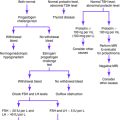Chapter 33 PRETERM LABOR
Preterm labor is the leading cause of perinatal morbidity and mortality in the United States. Preterm labor is characterized by increased uterine irritability and cervical effacement or dilatation, or both, before 37 weeks of pregnancy. Preterm labor usually results in preterm birth, which affects 8% to 10% of births in the United States. Unfortunately, in most cases, the precise causes of preterm labor are not known. Risk factors associated with preterm labor are outlined later in this chapter. Women with a history of preterm delivery have the highest risk of recurrence, estimated to be between 17% and 37%. Approximately 40% of spontaneous births following preterm labor are thought to be caused by infection. Screening and treatment for asymptomatic bacteriuria early in pregnancy, which prevents pyelonephritis during pregnancy, has helped reduce the rate of preterm delivery.
Fetal fibronectin in cervical and vaginal secretions may be a biochemical marker for preterm labor. The presence of fetal fibronectin in the cervix or vagina is infrequent after the 20th week of gestation and rare after the 24th week. After the 24th week, the presence of fetal fibronectin may indicate detachment of the fetal membranes from the deciduas. Studies suggest that fetal fibronectin is a biochemical marker for labor. However, there is no evidence to suggest that the use of the assay for fetal fibronectin would result in a reduction in spontaneous preterm birth. Many questions still remain as to how to use the results of fetal fibronectin assays, both positive and negative, in clinical care.
Risk Factors for Preterm Labor
Key Historical Features
Suggested Work-Up
| Urine culture | Routine screening for asymptomatic bacteriuria, which should be performed at the initial prenatal visit; after therapy is completed, repeat of a urine culture to ensure eradication of infection |
| Tocodynamometry | To measure uterine activity |
| Sterile speculum examination | To evaluate for cervical dilatation, vaginal bleeding, or infection |
| Nitrazine test and fern test | To determine whether rupture of membranes has occurred |
| Measurement of fetal fibronectin obtained from vaginal fluid | May improve the diagnostic accuracy of preterm labor |
| Uterine ultrasonography | May be used alone or together with measurement of fetal fibronectin to try to diagnose preterm labor |
Additional Work-Up
| DNA test or culture for gonorrhea | Recommendations for routine screening vary: The Centers for Disease Control and Prevention (CDC) recommends that every pregnant woman undergo gonococcal screening at the initial visit; however, the American College of Gynecology and American Academy of Family Practice recommend screening only for patients with risk factors for gonorrhea |
| Urinalysis | If urinary tract infection is suspected |
| DNA test or culture for gonorrhea and chlamydia | If the patient has risk factors for infection or if physical examination suggests infection (mucopurulent cervical discharge and a hyperemic cervix) |
| Wet-mount examination, whiff test, and measurement of vaginal pH level | If bacterial vaginosis is suspected on examination (malodorous, thin discharge) |
| Wet-mount microscopy | If Trichomonas infection is suspected (copious yellow-gray homogenous discharge and an alkaline vaginal pH) |
Ables AZ, Chauhan SP. Preterm labor: diagnostic and therapeutic options are not all alike. J Fam Pract. 2005;54:245-252.
ACOG Committee on Practice Bulletins–Gynecology. ACOG Practice Bulletin No. 80: Premature rupture of membranes. Clinical management guidelines for obstetrician-gynecologists. Obstet Gynecol. 2007;109:1007-1019.
Chatterjee J, Gullam J, Vatish M, et al. The management of preterm labour. Arch Dis Child Fetal Neonatal Ed. 2007;92(2):F88-F93.
Cram LF, Zapata MI, Toy EC. Genitourinary infections and their association with preterm labor. Am Fam Physician. 2002;65:241-248.
Goldenberg RL, Goepfert AR, Ramsey PS. Biochemical markers for the prediction of preterm birth. Am J Obstet Gynecol. 2005;192(5 Suppl):S36-S46.
Simhan HN, Caritis SN. Prevention of preterm delivery. N Engl J Med. 2007;357:477-487.
Weismiller DG. Preterm labor. Am Fam Physician. 1999;57:2457-2464.





